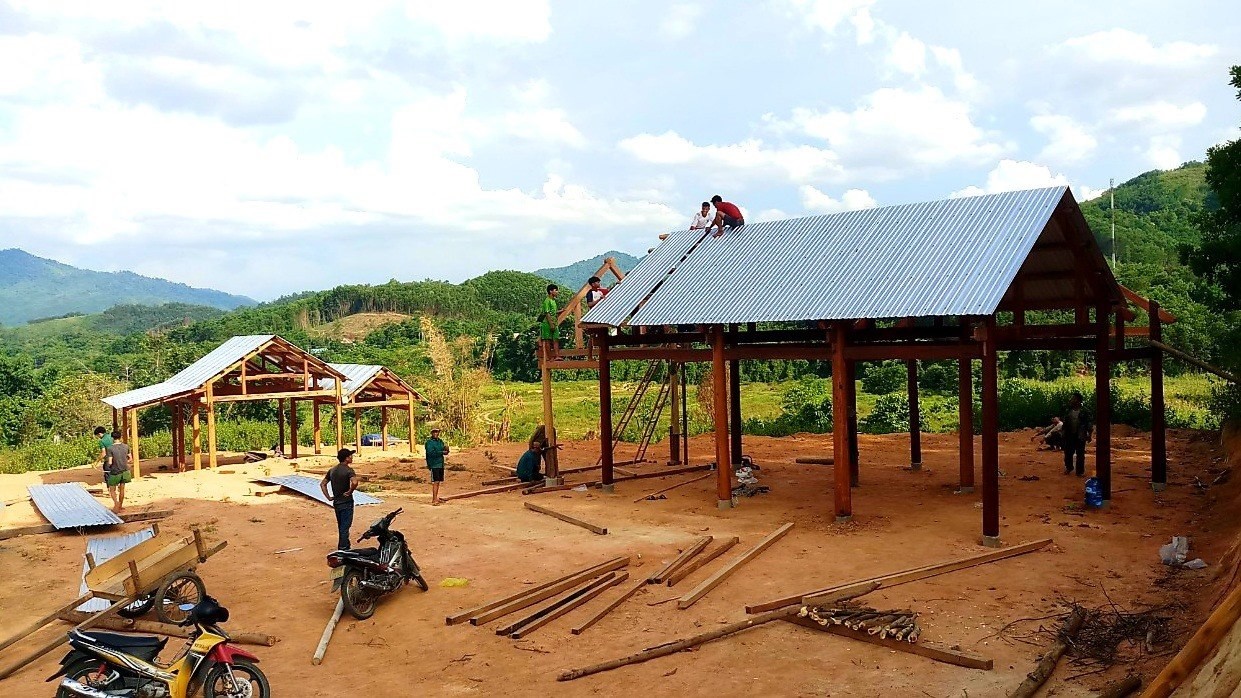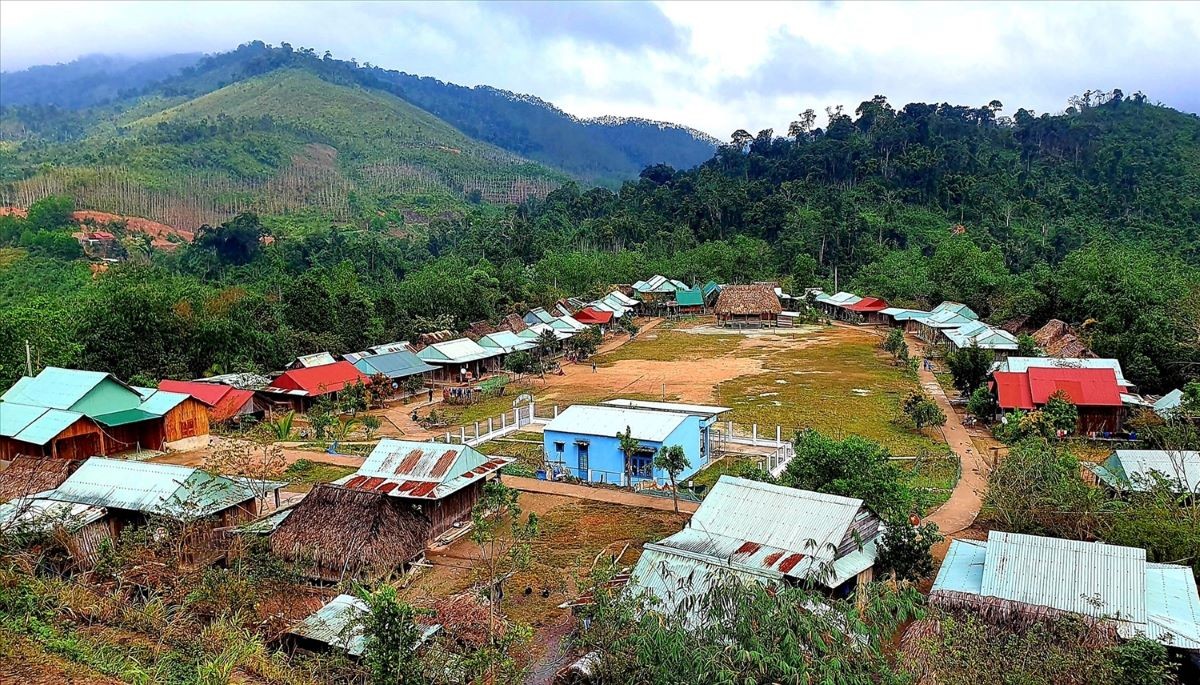
Quang Nam: Population relocation for development and sustainability
Latest
 |
| Quang Nam is making efforts to relocate and stabilize residents in 9 mountainous districts. (Photo: Quang Nam Newspaper) |
Mobilizing State's resources and People's strength
Quang Nam, characterized by its extensive mountainous terrain and significant elevation variations, frequently experiences climate change-induced landslides. The provincial People's Council resolution on resettling mountainous populations, active for nearly a decade, reflects a judicious approach endorsed by the Party and State. From 2017-2021, over 3,200 households were successfully resettled, unaffected by the region's major floods and landslides. Building upon this success, Quang Nam aims to resettle an additional 7,000 households, integrating livelihood development into this initiative.
Nam Tra My district, facing challenges due to its sparse population and poverty, has ambitiously reorganized 242 residential areas down to 115, creating a significant impact on living standards. Since 2017, 62 areas accommodating 2,857 households from the Ca Dong, Sedang, and M'Nong ethnic groups have been resettled, with a budget of 166 billion VND.
Previously, the ethnic minority groups in Nam Tra My, who lived by shifting cultivation and migration, faced significant challenges in stabilizing their lives. Factors like inadequate living conditions and landslide risks necessitated relocation. The growing population and the establishment of new villages posed challenges to infrastructure investment. In 2017, Nam Tra My, originally with 43 villages (now 35), had to manage 242 scattered residential areas, which hampered daily life and education, and contributed to high poverty rates.
Addressing this, Nam Tra My initiated a state and community collaborative project for population resettlement and reorganization. In 2017, the district embarked on this project in 15 areas, covering 475 households across 10 communes, with a budget exceeding 71 billion VND, of which 49.2 billion VND was state-funded for infrastructure, and 21.8 billion VND was community-raised.
The new residential areas are comprehensively planned, ensuring adequate space for living, farming, and animal husbandry, and facilitating infrastructure development like roads, schools, and water systems. The district's mobilization of its political system from top to grassroots levels has been pivotal in educating households about these policies, leading to significant progress. Residents actively participate in the project, with some families donating land for community development.
In Tay Giang district, after 18 years of implementing the project, 123 resettlement sites over 374 hectares have been established, stabilizing over 5,530 ethnic minority households. This project links resettlement with sustainable poverty reduction and production development.
 |
| Localities in Quang Nam province prioritize resources to build many concentrated resettlement areas to move people out of dangerous places. (Photo: Ethnic Newspaper) |
Life transformation through resettlement
Por’ning village in Lang commune, Tay Giang district, exemplifies a successful resettlement area, housing 170 Cơ tu families, about 600 individuals. It features a central communal house surrounded by family homes, creating a vibrant community space.
Mr. Bling Lam, 75, vividly recalls the early days of Bơr’ning village, nearly 20 years ago. “Back then, this land was not flat like it is now; it was a hill over 50 meters high with just a few houses. The state leveled it to create a wide area for our community to build homes. Previously, Bơr’ning consisted of three scattered villages, but now it's concentrated in one place. Currently, the whole commune of Lang has 7 centralized residential areas. Living like this is very convenient for the children to go to school. Although we have to travel a bit farther to our fields, we have managed to overcome this,” he said.
Mr. Bhling Mia, Party Secretary of Tay Giang district, noted that the planning and resettlement work can be seen as a new revolution for the government and people of Tay Giang district. “By organizing and arranging concentrated residential areas, the district is able to restructure and maximize the potential of residential and agricultural land, converting previous residential sites for medicinal plant cultivation, fruit tree planting, and transforming production methods for the locals,” he stated.
Mr. Trinh Minh Hai, Head of Agriculture and Rural Development Department of Nam Tra My district, shared: “The execution of population resettlement has facilitated the investment in integrated and effective infrastructure, suitable for the actual conditions of the locality. It has progressively perfected the infrastructure network, accelerating the process of rapid and sustainable poverty reduction, and enhancing the material and spiritual life of the residents, particularly the ethnic minorities.”
Emphasizing the effectiveness of the mountainous area resettlement policy, Mr. Ho Quang Buu, Vice Chairman of Quang Nam Provincial People's Committee, said: “Following the success in the 2021-2025 period, Quang Nam continues to implement the resettlement and stabilization of over 7,820 households, with an estimated total implementation budget of about 968 billion VND. Along with the resettlement aimed at disaster prevention, it will be linked to livelihood development for the highland communities.”
The result of the resettlement policy has gradually transformed the appearance of villages and hamlets towards more elegant designs. The residents have a better life in their new homes, creating conditions for livelihood stabilization. Many planned resettlement points are in line with the rural new town construction planning and local socio-economic development directions, contributing to sustainable poverty reduction and the construction of new rural areas, as well as disaster prevention, and improving the quality of life of the mountainous district residents, especially the ethnic minorities.
| On October 25, the Quang Nam Provincial People's Committee issued Decision 2289/QĐ-UBND implementing Resolution No. 13/2023/NQ-HĐND dated September 22, 2023 by the Provincial People's Council, stipulating the support level for the demolition of temporary and dilapidated houses in the province for the 2023-2025 period. From now until 2025, the province plans to allocate over 407 billion VND from the provincial budget, social security fund, and socialized contribution sources to support the demolition of 15,735 temporary and dilapidated houses, including building 8,675 new houses and repairing 7,060 houses. Specifically, in 6 poor districts including Phuoc Son, Tay Giang, Nam Giang, Dong Giang, Nam Tra My, and Bac Tra My, 8,179 households will receive support for demolishing temporary and dilapidated houses, among which 7,606 are poor households and 573 are near-poor households. The support standard for these groups, in addition to the national target program's funding, will include an additional 14 million VND for each new house built and 7 million VND for each house repaired. |

















